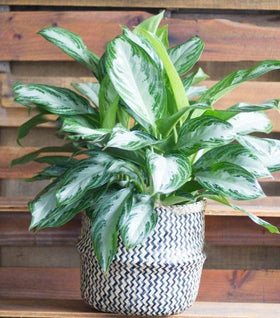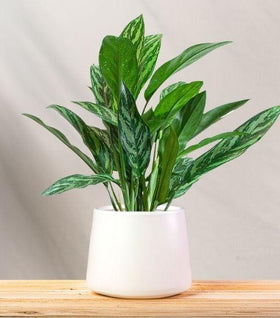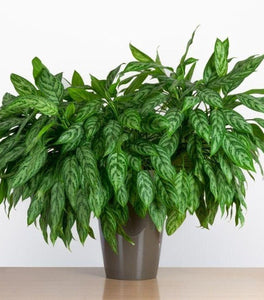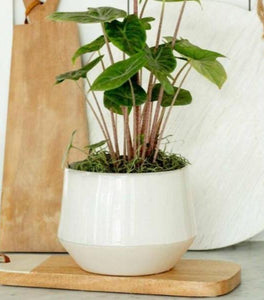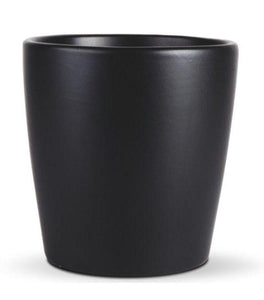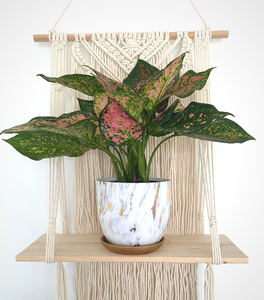Images Depict Mature Plants
Aglaonema Jubilee for Sale Online
Aglaonema Jubilee Plants are low-light house plants with green leaves and silver centers. The leaf shape is more narrow than other Chinese Evergreens. The bright, glossy foliage matches virtually any decor and brightens any kitchen, living room, bathroom, or bedroom.
Aglaonema Jubilee is an easy to care for, low maintenance houseplant that does best if kept away from drafts or heat vents and is in low fluorescent to bright, indirect light.
| Hardiness Zone: | 9-11 |
|---|---|
| Mature Height: | 30 to 36 Inches |
| Mature Width: | 24 to 30 Inches |
| Classification: | Colorful foliage, clean air plant |
| Sunlight: | Fluorescent to bright indirect light |
| Habit: | Upright habit |
| Flower Color: | No flowers |
| Foliage: | Green and silver |
| Water Requirements: | Likes to dry out some between watering; If unsure, do not water |
| Uses: | Attractive plant to be featured or in the background of any room in the house, does well with minimal care |
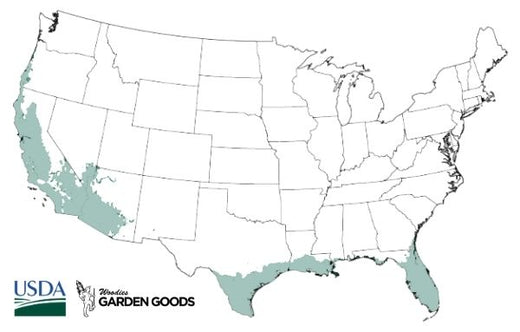
How to Care for Aglaonema Jubilee
Be sure to read our planting instructions to ensure a healthy and happy plant for years to come!

What is the best soil for Aglaonema Jubilee?
Aglaonema Jubilee houseplants thrive in well-balanced potting mixes with peat moss, perlite, and vermiculite. Allow your plant's soil to dry some between watering. Its soil takes a long time to compact, so allowing it to dry out every so often will not harm your plant. Typically, any all-purpose or organic potting soil will work perfectly for your Aglaonema. You can add a granular, slow-release fertilizer while planting to help your plant thrive in the transplanting process.
How do I fertilize Aglaonema Jubilee?
Indoor houseplant fertilizers fall into two groups: water-soluble, liquid quick release, and granular, slow-release fertilizers. Jack's Classic Indoor plant food works well as a powder, quick-release fertilizer mixed with water to quickly provide nutrients to a plant that has been in a container for an extended time. On the other hand, Osmocote Indoor/Outdoor is an option as a granular, slow-release fertilizer while potting and planting. Any fertilizer offers nutrients that help plants with the transition to a new environment.
How do I water Aglaonema Jubilee?
Water your Aglaonema Jubilee relatively infrequently, as the plant likes to dry out some between watering. The easiest way to tell if a plant needs water is by the weight of the container. If the container is heavy and the foliage is upright, your plant does not need water. However, a light pot and limp foliage indicate your plant needs water. Sometimes, water pours out of the container without being retained by the soil. An effective way to solve this problem is by soaking the dry potting soil in a small dish or saucer. Do not water the foliage of your Aglaonema because you could damage their leaves. Also, do not overwater your plant because you could cause root rot disease. If you're unsure, it is always better to let the plant go dry instead of drenching it with water.
How Do I Plant My Aglaonema Jubilee Plant?
We suggest planting your newly purchased Aglaonema Jubilee into a container 2"-4" wider and 3"-5" deeper than the container it is in currently. Use a well-draining potting mix, and be sure to disturb the roots when transplanting. We recommend adding a slow-release fertilizer to the new potting mix. The most common cause of plant death after transplanting is planting the new plant too deep. We do not recommend planting in a hole any deeper than the soil line of the plant in the pot. A good rule is that you should still see the soil the plant was grown in after back-filling the container. Keep in mind that this new potting mix will retain more moisture than the previous container, so watering, in the beginning, should be less frequent.





